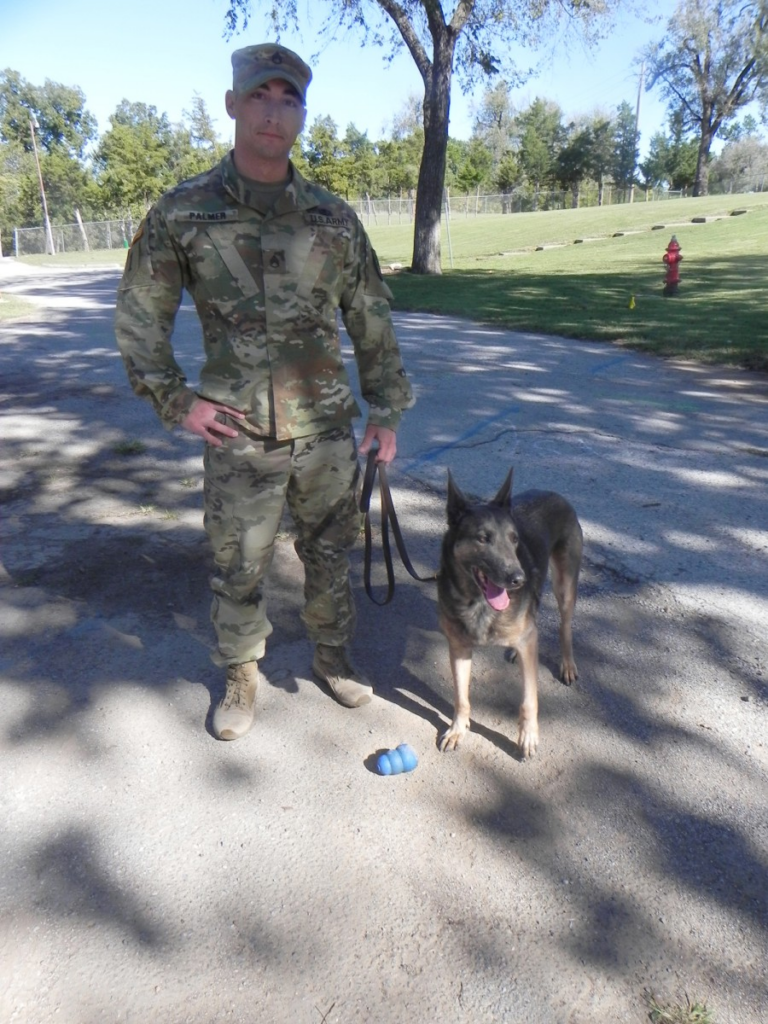By Christina SteinerNovember 9, 2017
FORT SILL, Okla., Nov. 9, 2017 — Two Soldiers in the 902nd Military Working Dog (MWD) Detachment here have adopted the dogs that used to be their partners. Both dogs retired from military work — one this year, the other in 2013.
They explained that adopting MWDs is the rule, not the exception. Everything possible is done to adopt out dogs, first to their handlers, and if the handlers can’t take them, they are offered to the public. They are only euthanized if they have cancer or another terminal illness and there is no other way to treat them. It is a last resort, though that wasn’t always the case. Retired MWDs once were viewed as excess equipment and euthanized — even if healthy — at the end of their military careers.
Staff Sgt. Daniel Franklin, MWD plans NCO with the 902nd, adopted Sue, his canine partner at Fort Carson, Colo., for three years. Sue is nearly 10 years old and retired in May.
Sgt. Jarred Palmer, squad leader with the 902nd, adopted Zzazu, who he worked with for five years at Fort Benning, Ga., and in Germany. Palmer returned in July from a deployment from Iraq, but with another dog because Zzazu retired from duty in December 2013.
Palmer explained that Zzazu has a bit of PTSD (post traumatic stress disorder) from her Army duties. “We’re working on that. Aside from PTSD she is fine. Actually, there is canine PTSD — C-PTSD.” That is to distinguish it from Soldiers’ PTSD. Zzazu is a Belgium Malinois breed, which, in addition to German and Dutch shepherds, is one of the more common dog breeds for MWDs. This is because all three breeds are aggressive, smart, loyal and athletic — traits needed for military work. Dogs also have a more acute sense of smell and will defend their handlers until the very end.
Sue trained as a patrol explosive detection dog –enhanced capabilities, while Zzazu was a specialized search dog.
Franklin described Sue. “She’s the best dog I’ve ever had. She keeps the puppy (a pit bull) in line. She’s super hyper, has a high drive and is starting to show her age a bit. She retired because she has pinched nerves in her spine and can’t do bite work. It’s sort of an age-related ailment for German shepherds.
“The criterion for adopting these dogs is pretty straightforward,” Franklin said. “If the dog is aggressive and you have kids, don’t get that dog. If it’s a dog fighter, don’t get it. The application also has you state where you live and will make sure you establish a vet. I use the Fort Sill vet. “
Some things make MWDs different from other dogs one may find at a pet store or shelter, and it is important to note these differences before considering adoption.
According to research from petsforpatriots.org — an organization dedicated to MWDs. Not every retired MWD makes a great addition to the family. They are highly trained, often for lethal purposes, and traits that are desirable in a military canine might make them unsuitable as a family pet. While fiercely loyal, they are often independent-minded and have different triggers, or trained responses, to various verbal or physical commands. In many cases, these dogs are not recommended for families with small children or other pets. Some are deemed unsuitable for adoption for a variety of reasons, including extreme aggression.
Because of their unique temperaments and training, the military does not surrender decommissioned military working dogs to shelters, rescues or sanctuaries for placement.
MWD units deploy individual Soldiers and their dogs separately rather than with entire units. The team deploys worldwide where needed to help detect drugs and explosives.
Franklin and Palmer have 31K military occupational specialties (MOS), which is military working dog handler. Both started out as military police.
The 31K MOS is new, created within the last three years. Previously, it was an additional skill identifier combined with the military police MOS.
Service members initially undergo nine weeks of basic combat training, which can be at any post, then seven weeks of phase one advanced individual training at Fort Leonard Wood Military Police School, Mo., and 11 weeks of phase two AIT at Joint Base San Antonio – Lackland, Texas.
Most dogs train about four months, also at Joint Base San Antonio. They spend their first three months learning drug or explosives detection, and the next three months mastering obedience and patrolling.
More than 30,000 dogs have served in the military since it started employing them. About 2,500 dogs serve today.
The 902nd Military Working Dog Detachment is authorized reports to the 40th Military Police Detachment, which is part of the Fort Sill Garrison.
Working dogs in general are also assigned to law enforcement agencies. The military’s employment of dogs goes back to the Revolutionary War.
Initially, service members used dogs as pack animals. Later, they used them to kill rats.
World War II saw the biggest surge in military working dogs. They worked as sentries (guards or lookouts), then they worked as scouts, messengers and mine detectors.
The K-9 Corps was established in 1942.
The Fort Sill Tribune has published other articles and photographs of MWDs on post. You can find a sampling at www.swoknews.com, or call 580-442-5150.
usa image
usa image

